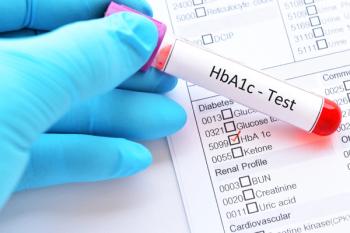
Diabetes
Latest News

Latest Videos

Podcasts
CME Content
More News

While the clinic did not significantly reduce hospital readmission rates for patients with diabetes, it was able to decrease the time to follow-up and improve long-term diabetes outcomes following hospitalization.

An analysis covered trends in mortality caused by diabetes and diabetic kidney disease across North, South, and Central America from 2000 to 2019.

Compared with a hemoglobin A1c (HbA1c) level of 5.5%, adolescents with overweight or obesity were 72 times more likely to have diabetes if their HbA1c was 6.3% to 6.4%.

What Happens to Patients With Diabetes When Semaglutide Dosing Is Disrupted? Dr Ian Neeland Explains
Possible long-term consequences for patients with diabetes forced to switch to alternative medications during the semaglutide shortage include the risk of losing ground in glycemic control, having uncontrolled diabetes with associated symptoms, and other adverse events.

Our most-viewed videos include interviews about a type 2 diabetes reversal program with impressive 6-month results, concerns over service denials in certain health plans, the Enhancing Oncology Model, and more.

Our most-read articles on diabetes covered racial biases in type 2 diabetes risk prediction models, cardiovascular disease as a leading cause of hospital admissions in patients with diabetes, and much more.

Our most-read coverage of American Society of Nephrology Kidney Week 2023 highlighted discussions on the challenges of medication dose adjustments in chronic kidney disease, the impact of LGBTQ+ health care disparities on kidney outcomes, and much more.

Adding metformin to the insulin regimen for pregnant patients with preexisting type 2 diabetes (T2D) or gestational diabetes diagnosed early in pregnancy did not reduce the risk of neonatal adverse outcomes.

Among adults with type 2 diabetes who started noninsulin second-line therapy, most modified treatment within 1 year. Discontinuation was by far the most common modification.

Adults with type 2 diabetes (T2D) undergoing endocrinology care are more likely to experience less favorable hemoglobin A1c improvements if they only use telemedicine compared with patients using in-person care or a mix of both.

Researchers identified a value of at least 0.25 to be a minimal clinically important difference (MCID) in diabetes distress, and MCID values of 0.38 and 0.39 for emotional and interpersonal distress subscales and physician and regimen distress subscales, respectively.

Chase Hendrickson, MD, MPH, Vanderbilt University Medical Center, attributes gaps in continuous glucose monitoring (CGM) prescribing rates to patient demographics, endocrinologists' longer familiarity with the technology, and the availability of ancillary support in endocrine clinics.

The strongest associations between diabetes and colorectal cancer risk were observed in participants with a recent diabetes diagnosis and those who had not undergone recent colonoscopy, underscoring the significance of cancer screening.

Tirzepatide is already approved to treat type 2 diabetes, and is now approved for chronic weight management in adults with obesity or overweight with at least 1 weight-related condition.

Regardless of kidney disease subtype, biomarkers can successfully ascertain risk of kidney disease progression, said Steven Coca, DO, MS, of the Icahn School of Medicine at Mount Sinai.

This report illustrates how providing vital diabetes medications to uninsured patients through a charitable medication distributor improves clinical outcomes.

Providing at-home hemoglobin A1c test kits increases testing rates and facilitates hemoglobin A1c reduction over time among members of a large commercial health plan with diabetes.

The generic drug market focuses on price. However, multiple generic metformin drugs have been recalled due to poor drug quality. The authors examine price and quality after these recalls.

Interviews highlight the importance of culturally-tailored diabetes education to address health care disparities in the Mexican American community.

New research found that people who routinely eat high amounts of red meat have a 62% higher risk of developing type 2 diabetes, supporting dietary recommendations to limit red meat consumption.

Among individuals with a diagnosis of type 2 diabetes across the United States, income level, hemoglobin A1c, and comorbidity burden were the primary patient-level drivers of the use of newer antidiabetic agents.

Blood tests offer a less invasive and more accessible means of detecting Alzheimer disease; Democrats address a year-long Adderall shortage; A new study shows significantly improved clinical outcomes in Type 2 diabetes management with a digital behavioral therapy app.

Ischemic and coronary heart disease were the 2 major cardiovascular disease (CVD) subtypes contributing to hospital admissions among patients with diabetes.

Annualized costs for the 24-month study period were highest among patients with both NASH and T2D, highlighting the incremental cost of adding an additional diagnosis for comorbid NASH or T2D.

Matthew Crowley, MD, MHS, associate professor of medicine, Duke University School of Medicine, discusses telehealth initiatives at Duke Health, as well as overcoming virtual challenges and barriers that underserved and underinsured patient populations who need diabetes care face.


















































